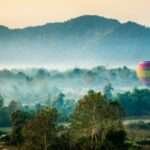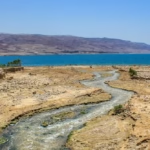UNESCO World Heritage Centre
Lake Titicaca is a large high-altitude freshwater lake on the Peru–Bolivia border at about 12,500 feet (3,810–3,812 meters) above sea level. It’s commonly called the world’s highest navigable lake—meaning navigable to larger commercial vessels—covering about 3,232 sq mi (8,372 km²), with depths reaching roughly 920 ft (280–284 m).
Where & What Is Lake Titicaca?
Lake Titicaca lies on the northern Altiplano, straddling the border of Peru (west) and Bolivia (east). Its surface sits around 12,500 ft (≈3,810–3,812 m), an altitude that shapes its climate, ecology, and even daily life. Because relatively large ships operate here, Lake Titicaca is widely referenced as the highest navigable lake on Earth—“navigable” referring to commercial craft, not just small boats.
Two ports anchor travel: Puno, Peru, and Copacabana, Bolivia. From these, visitors reach the Uros floating reed islands and natural islands like Isla del Sol and Taquile. UNESCO also notes Titicaca as the largest freshwater lake in South America and among the world’s few ancient lakes.
Quick Map & Key Facts
Center point: 15.83° S, 69.33° W (≈ 15°49′48″ S, 69°19′48″ W). Elevation: 12,500 ft (≈3,810–3,812 m). Orientation: northwest–southeast, about 120 mi (190 km) long and 50 mi (80 km) wide, on the Peru–Bolivia border.
| Fact | At a Glance |
|---|---|
| Surface area | 8,372 km² (3,232 sq mi) |
| Maximum depth | 280–284 m (920–932 ft) |
| Mean depth | 107 m (351 ft) |
| Volume | ≈893 km³ (≈214 cu mi) |
| Shoreline length | ≈1,125 km (699 mi) |
| Sub-basins | Lago Grande (deep north) & Wiñaymarka/Lago Menor (shallower southeast), linked by the Strait of Tiquina |
| Outlet | Río Desaguadero (most water loss is by evaporation at altitude) |
| Main ports | Puno (Peru) & Copacabana (Bolivia) |
| Notable islands | Uros floating reeds (near Puno); natural islands Isla del Sol, Isla de la Luna, Taquile |
Physical Geography & Key Numbers
Titicaca consists of two sub-basins linked by the narrow Strait of Tiquina. The larger northern basin is commonly called Lago Grande (or Lago Chucuito); the smaller southeastern basin is Wiñaymarka (also Lago Pequeño). This layout explains why depths vary sharply—Lago Grande drops well over 280 m (~920 ft), while Wiñaymarka is much shallower along extensive reed beds.
The shoreline meanders for roughly 1,125 km (699 miles), enclosing a water volume near 893 km³ (214 cubic miles). With a mean depth close to 107 m (351 ft), Titicaca stores a significant fraction of the Altiplano’s fresh water and has an unusually long residence time (water renewal) of ~1,300 years.
Lago Grande vs Wiñaymarka
Lago Grande (≈7,100 km²) is the deep, open water body; Wiñaymarka (≈1,400 km²) is shallower and fringed by vast totora reed marshes that shelter fish and birds and support traditional livelihoods. Recent remote-sensing studies underscore the contrasting average depths and the ecological importance of these reed belts.
Water Balance, Climate & Seasons
Titicaca’s hydrology is distinctive. More than two dozen rivers feed the lake; the largest inflow is the Ramis in the north. The lake’s only outlet is the Río Desaguadero, flowing south toward Lake Poopó. However, long-term studies show that the majority of Titicaca’s water loss is via evaporation at high altitude, while a smaller portion exits through the Desaguadero. Estimates vary by method and period: classic syntheses report ~90–95% loss by evaporation and ~5–10% by outflow.
Seasonally, the Andean summer (roughly December–March) brings most rainfall; April–November is drier, with clear skies, strong sun, and cold nights. Evaporation and inflow swings can shift lake levels significantly, affecting navigation channels and marsh habitats—an issue monitored by the binational lake authority ALT.
Nature & Conservation
Lake Titicaca is a Ramsar Wetland of International Importance (designated in 1997–1998 on both the Peruvian and Bolivian sides) thanks to its biodiversity and extensive high-Andean wetlands. The shallow margins host vast totora reeds; over 530 aquatic species are recorded for the system.
Flagship endemics include the Titicaca water frog (Telmatobius culeus) and the Titicaca grebe (Rollandia microptera). The grebe is listed as Endangered by BirdLife International; the frog is assessed as threatened on major conservation lists and has suffered declines linked to pollution and introduced fish.
Environmental pressure is real. The Global Nature Fund named Titicaca its “Threatened Lake of the Year 2023,” spotlighting urban pollution and habitat stress in bays near population centers. Conservation projects increasingly focus on wetland restoration, sewage treatment, and bycatch reduction in local fisheries. :contentReference[oaicite:13]{index=13}
People, Culture & Islands
Indigenous Aymara and Quechua communities have lived around Titicaca for millennia. In Andean tradition, the lake is linked to Inca origin myths—Manco Cápac and Mama Ocllo said to have emerged from its waters—an idea echoed in archaeological finds and cultural memory today. National Geographic has covered underwater offerings and ritual sites in and around Isla del Sol.
The best-known cultural attraction is the Uros floating islands near Puno, woven from layered totora reeds and continually rebuilt. While tourism has modernized livelihoods and sparked debates about authenticity, the reed-island craft remains a living heritage and a draw for visitors seeking community-based experiences.
Why “world’s highest navigable”? Because Lake Titicaca has long supported large commercial vessels, from 19th-century steamers to today’s rail car-floats. Historic ships such as the Yavari were built in Britain, shipped in thousands of pieces over the Andes, and riveted together on the lakeshore—remarkable feats of engineering at 12,500 ft.
In operation today, the dual-gauge Manco Cápac car-float links Puno (Peru) and Guaqui (Bolivia), illustrating that “navigable” here means more than kayaks—it means lake transport integrated with national rail networks.
Visiting Lake Titicaca (Travel Tips)
Altitude & health. At ~12,500 ft (≈3,810 m), plan to acclimatize: sleep your first night in Puno or Copacabana, walk slowly, hydrate, and limit alcohol. Day trips to Uros and Taquile are suitable once you feel adapted; steep island paths will still feel demanding.
When to go. The dry season (May–September) brings blue skies and cold nights; the wet season (December–March) is greener with afternoon storms. Boats may adjust schedules with wind and lake-level conditions.
Responsible travel. Choose licensed community-run tours, ask before photographing residents, and avoid buying wildlife or reed items sourced unsustainably. On Peruvian shores, parts of the lake and wetlands fall within the Titicaca National Reserve, established to protect ecosystems and cultural heritage.
FAQ
Is Lake Titicaca really the world’s highest navigable lake?
Yes—navigable to larger commercial vessels such as historic steamers and today’s rail car-float. Many smaller lakes sit higher, but they don’t support comparable commercial navigation.
How deep is Lake Titicaca?
Maximum depth is about 920–932 ft (280–284 m); mean depth is roughly 351 ft (107 m). Depth varies by basin, with Lago Grande much deeper than Wiñaymarka.
Where does the water go—does the lake drain to the sea?
The only outlet is the Río Desaguadero, but most water is lost to evaporation at high altitude. Studies place evaporation around ~90–95% of total losses, with the remainder flowing out via the river.
What wildlife is unique to Titicaca?
The Titicaca grebe (Rollandia microptera, Endangered) and the Titicaca water frog (Telmatobius culeus) are emblematic endemics, alongside reed-marsh birds and native Orestias fishes.
Why is UNESCO mentioned if Titicaca isn’t a World Heritage Site?
Titicaca appears on UNESCO’s Tentative List (Peru) as an ancient, high-Andean lake of outstanding value. That signals recognized potential for future inscription, though it isn’t yet on the official World Heritage List.
What’s the best base for visiting—Puno or Copacabana?
Both work. Puno (Peru) has more tour options to Uros and Taquile; Copacabana (Bolivia) is the gateway to Isla del Sol and Isla de la Luna. Choose based on your route, border formalities, and interests.
What Did We Learn Today?
- Titicaca sits at ~12,500 ft (≈3,810–3,812 m), the highest lake navigable to commercial vessels.
- It spans about 3,232 sq mi (8,372 km²) with a max depth ~920–932 ft (280–284 m).
- Most water loss is via evaporation; the Desaguadero carries the rest toward Lake Poopó.
- The lake is a Ramsar site with notable endemics like the Titicaca grebe and Titicaca water frog.
- Historic steamers and a modern rail car-float help define its “navigable” status today.





